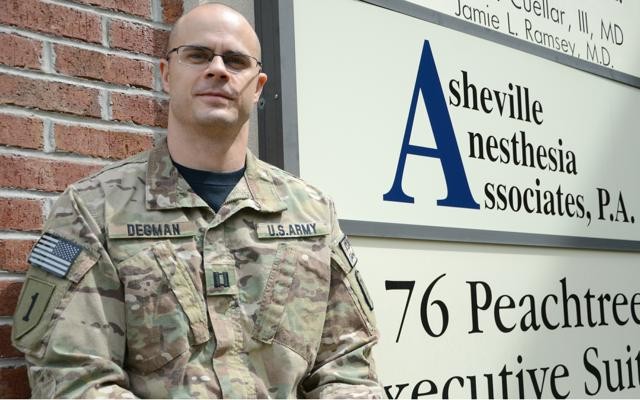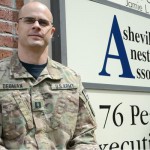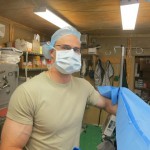- Stateside: Dustin Degman works as an anesthetist at Asheville Anesthesia Associaties, and also serves in the Army Reserve. Recently, he was deployed to Afghanistan. Photo by Caitlin Byrd
- Abroad: For six months, Degman worked as a nurse anestheticst in Afghanistan as part of a forward surgical team. He told Xpress that the experience was, “As advertised: gun shot wounds or IEDS.” Photo courtesy of Dustin Degman
Each night before he went to sleep in his cot in Afghanistan, Asheville resident Dustin Degman set out three sets of clothing: one for surgery, another for a normal day on the base and a third for incoming mortar fire.
For three months, this was part of Degman's routine while he served as a certified nurse anesthetist at a forward operating base just outside of Orgun, a village in northern Afghanistan.
“It's as advertised: gun-shot wounds or IEDS,” the Army reservist says. “Consequently, we provide anesthesia services differently in Afghanistan than we do here. It's so different.”
Degman, who works as a certified nurse anesthetist at Asheville Anesthesia Associates, returned from his tour of duty on Feb. 14. He sat down with Xpress to talk about those differences and share his experiences about what it was like providing care abroad during a time of war.
Mountain Xpress: You just got back from serving in Afghanistan. Tell us about your role.
Dustin Degman: I'm a nurse anesthetist, a CRNA, that works here at Asheville Anesthesia, and I go to five different clinical sites: Mission Hospital; St. Joseph's; Orthopedic Surgery Center; The Eye Center; and Asheville Surgery Center. I go to those sites and provide anesthesia much like what I did when I was overseas. So my role in the civilian sector fit well with what the army expected of me.
And you were part of a forward surgical team. How is that team put together? What does it do?
In the level of fighting, there are different roles. Role 1 is at the field of battle, and Role 2 is behind the battlefield lines. Role 2 is a forward surgical team, which tends to be what they call a forward operating base or an FOB.
The function of a forward surgical team is to have these small teams that deal only with trauma. So, what's trauma? Three things define trauma: life, limb or eyesight. So we take care of anything that fell under that. It was almost like stabilizing. You get [a patient], find the injury as quickly as possible, fix the injury as quickly as possible and send them to role 3. If you get hurt in Asheville, you go to the ER, you follow the ER to the CT scans, you go the CT scan to the OR, we fix you and you go to the ICU. You see the full process unfold in front of you. Out there, you just see them from when the medic's been trying to take care of them until you think you've fixed them enough to send them on to the next hospital. I guess the only way I [can] compare it is if someone had a bad accident in Murphy and you're just trying to stabilize them enough to get them to Asheville, and then Asheville to Charlotte. That kind of transition.
A true FST has 20 people, but we were broken up into two teams because usually an FST has two ORs. We had just one.
What did the operating room look like?
Everything's makeshift. Our little OR table [was a] plywood board with molars on it. [Degman points to a photo of the operating room, before showing the operating room during a surgery.] A lot of my patients were Afghans, a lot of them were special forces or CIA.
How does medical care differ from the care you provide stateside?
It was so different. The whole algorithm of caring for soldiers is much different than caring for civilians and Americans. All of our clientele are 20-40 and healthy. So that's a benefit for us. Our injuries here, in Asheville, could be anything from pediatric to mostly elderly. So the trauma spectrum is so wide here and it's so narrow there. You know what the injuries are going to be, you know the age demographics.
Therefore, if you get a trauma at Mission, you give two liters of fluid and assess the blood pressure. Out there, we want the blood pressure low to allow the clot to form. You don't want to put the pressure up, so tourniquets are heavily used, whereas we don't really use tourniquets here. There's a drug called TXA, tranexamic acid, which we use pretty heavily out there as a first-line. In the hospital, it's four units of pack cells to one unit of frozen plasma. So you have four units of oxygen carrying blood to one unit of plasma, which helps break the blood clots. Out there, the ratio's one to one.
What are some of the techniques that you took with you to Afghanistan, and what did you bring back?
Two weeks before I left for Afghanistan, in the middle of the night, we had a trauma. We were doing CPR to bring the patient in with a ruptured aortic aneurism. The outcomes of that usually aren't pretty; it's like 50-50, but we were already doing CPR. We had a rhythm that was working and then, when we came back to the OR, they were aysystole, and so, [the doctors say to each other], “Can we do an ultrasound on the heart and if there's no movement, can we go ahead and finish the case now?” Once you start, you're using a huge amount of resources and the outcome is so slim.
Sure enough, I go to Afghanistan, and an Afghan gets shot and it hits his aorta. We don't know how long it's been [since] this has happened. We get him in and we're starting a full code process, and it's one of those things where you have to decide: Do you utilize all your blood and plasma in a circumstance that you don't know how long it's been down. I asked the colonel, “Are you OK if we don't have a beat on the ultrasound, to possibly consider not going forward with this?”
So I took a little bit of what I learned here — two weeks before I left out, thinking I hate these circumstances, but I learned from it to being out there. It was a little more critical with our supplies because when the weather went bad, we had nothing.
Overall, what did you learn?
There are three things I've learned. The disconnect between military and civilian. You've always heard there's a disconnect between the soldier and the civilian. I'd say there [are] three things to help this. If you ever see a soldier in uniform, don't complain. Just don't complain. When they're coming home in an airport or they're in that uniform and you have a problem, it may seem like a big problem to you, but you're really going to disconnect the soldier from understanding what they're going through when you complain.
Rule No. 2 would be if you see someone in uniform, ask them what they do because they're very proud of the service they provide this country. It's an easy thing to do. Just go up and say, “Thank you for serving. What do you do?” Just saying, “Hey, what do you do in the Army or the Air Force,” and they'll probably be really proud to tell you what they do.
The third thing is if you see them in a multicam uniform in an airport, they're coming home. There's the pixel design, the ACU, Army combat uniform. But the multicam is made for Afghanistan. Ask them where they were. I'm sure they'll be proud to tell you what they've done. I think people feel like they should be left alone, when really they just want to feel part of feeling home again.
What are you most proud of from your service?
My goal was just to make the unit I was with better. And every day I would try to teach my techs or nurses something new. Whether it was starting IVs on me to make them more proficient [or] using a GlideScope, I'm most proud of trying to make that unit better than when I came. That was my whole purpose.
— Send your health-and-wellness news and tips to Caitlin Byrd at cbyrd@mountainx.com or mxhealth@mountainx.com, or call 251-1333, ext. 140.





This was a seriously fascinating article/interview. So many rich details, from a completely different world.